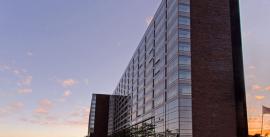Copenhagen is the capital and most populated city of Denmark, and second largest in Scandinavia, with an urban population of 1,246,611 and a metropolitanpopulation of 1,975,361 (as of 1 April 2014). It is situated on the eastern coast of Zealand, 42 km (26 mi) northwest of Malmö, Sweden and 164 km (102 mi) northeast of Odense. The city stretches across parts of the island of Amager and also contains the enclave of Frederiksberg, a municipality in its own right.
Founded as a Viking fishing village in the 10th century, Copenhagen became the capital of Denmark in the early 15th century. During the 17th century, under the reign of Christian IV, it developed into an important regional centre, consolidating its position as capital of Denmark and Norway with its institutions, defences and armed forces. After suffering from the effects of plague and fire in the 18th century, the city underwent a period of redevelopment. This included construction of the prestigious district of Frederiksstaden and founding of such cultural institutions as the Royal Theatre and the Royal Academy of Fine Arts. After further disasters in the early 19th century when Nelson attacked the Danish fleet and bombarded the city, rebuilding during theDanish Golden Age brought a Neoclassical look to Copenhagen's architecture. Later, following the Second World War, theFinger Plan fostered the development of housing and businesses along the five urban railway routes stretching out from the city centre.
Since the turn of the millennium, Copenhagen has seen strong urban and cultural development, facilitated by investment in its institutions and infrastructure. The city is the cultural, economic and governmental centre of Denmark; it is one of the major financial centres of Northern Europe with the Copenhagen Stock Exchange. In 2012, Copenhagen was third in the ranking of the richest cities in the world in terms of gross earnings, dropping from first place in 2009. Since the completion of the resund Bridge, a road, railway and tunnel project, the metropolitan area of Copenhagen has become increasingly integrated with the Swedish province of Scania and its largest city, Malmö, known as the resund Region. With a number of bridges connecting the various districts, the cityscape is characterized by parks, promenades and waterfronts. Copenhagen's landmarks such as Tivoli Gardens, the Little Mermaid Statue, the Amalienborg and Christiansborg palaces, Rosenborg Castle, Frederik's Church, and many museums, restaurants and nightclubs are significant tourist attractions. In addition to recent developments in the cityservice sector and the pharmaceutical industry, there have been a number of initiatives in clean technology, supporting the city's goal to be carbon-neutral by 2025.




